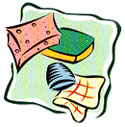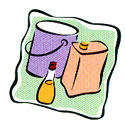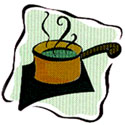 Routine daily care and maintenance of Corian® is easy. But, because cleaning practices differ around the world, please consult your local supplier of Corian® for specific recommended care and maintenance practices and products. Use the following procedures as a guide to everyday care for Corian® solid surfaces:
Routine daily care and maintenance of Corian® is easy. But, because cleaning practices differ around the world, please consult your local supplier of Corian® for specific recommended care and maintenance practices and products. Use the following procedures as a guide to everyday care for Corian® solid surfaces:
 Routine care:
Routine care:
There are three types of countertop finishes: matte, semi- gloss and gloss. All Corian® sinks and bowls have the matte finish. Soapy water or ammonia-based cleaners will remove most dirt and stains from all types of finishes. However, slightly different techniques must be used to remove difficult stains, depending on the finish.
 Preventing heat damage:
Preventing heat damage:
To prevent heat damage, always use a hot pad or a trivet with rubber feet to protect your Corian® . Hot pans, as well as some heat-generating appliances like frying pans or electric cooking pots,can damage the surface if a hot pad or trivet is not used.
 Preventing other damage:
Preventing other damage:
In most cases, Corian® can be repaired if accidentally damaged. However, be sure to follow the guidelines here to prevent any permanent damage to Corian® .
- Avoid exposing Corian® to strong chemicals, such as paint removers, oven cleaners, etc. If contact occurs, quickly flush the surface with water.
- Remove nail polish with a non-acetone-based polish remover and flush with water.
- Do not cut directly on Corian® countertops.
- Run cold water when pouring boiling water into sinks.
 *If you are uncertain about what finish you have, contact us by email or call us at:Â 405.820.3170
*If you are uncertain about what finish you have, contact us by email or call us at:Â 405.820.3170
Renewing Corian® Solid Surfaces:
Nicks, scratches and cuts are inevitable with any high-use product, including Corian® . But because Corian® is solid all the way through, it can easily be renewed to its original appearance as described below.
Minor damage, including scratches, general or chemical stains, scorches or burns, and minor impact marks, can be repaired onsite with a light abrasive cleanser and a Scotch-Brite* pad. For heavier damage, light sanding may be necessary. The following steps should be followed:
- Identify the extent of the damage and ascertain whether a minor repair will solve the problem. If unsure contact us.
- If the damage is minor, try to repair it with an abrasive cleanser or a Scotch-Brite* pad.
- If the above step is unsuccessful, hand sand with 400-grit wet and dry paper. To minimize dust, wet the surface before starting.
- If this is unsuccessful, use an electric sander and heavier-grit paper. Always make provisions to control dust.
- If this, too, is unsuccessful, you may need to consult a professional for other repair options. In this case, contact us.
Check out our Links section for additional resources.
